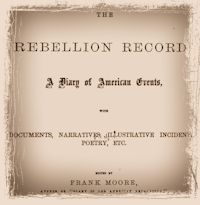February 7.—The reconnoissance which was sent out from the army of the Potomac on Friday night and yesterday morning, returned to-day, having ascertained the rebels’ exact position and probable strength. The Second corps (General Warren’s) took to Morton’s Ford at seven A.M. yesterday, under Generals Caldwell, Webb, and Hayes. General Alexander Hayes, commanding the Third division, led the advance in person, fording the river waist-deep, on foot, at the head of General J. T. Owen’s brigade. The rebel sharp-shooters, in rifle-pits, on the other side, kept up a galling fire, while a battery stationed on the hills to the right, and a mile beyond the ford, hotly shelled the advancing column. On reaching the south bank of the Rapidan, a charge was made on the rebel rifle-pits, and twenty-eight men and an officer captured. Much skirmishing ensued, and at midnight Warren recrossed his troops.—(Doc. 104.)
—Great excitement and consternation existed in Richmond, Va., on account of the approach of General Butler’s forces upon that place. Last night the bells of the city were rung, and men were rushing through the streets, crying: “To arms, to arms! the Yankees are coming!” During the remainder of the night there was an intense commotion everywhere visible. The Home Guard was called out, and the tramp of armed men could be heard in all directions. Cannon were being hauled through the streets; women and children were hurrying to and fro, and there was all the evidence of such a panic as had never before been witnessed in Richmond.
This morning there was no abatement in the excitement. The guards were all marched out of the city to the defences, and the armed citizens placed on guard over the prisoners. Horsemen were dashing to and fro, and the excitement among the prisoners to know the cause of all this commotion became intense. It was soon learned that a large cavalry and infantry force, with artillery, had made their appearance on the peninsula at Bottom’s Bridge, within ten miles of the city, a point so famous in McClellan’s peninsula campaign, and that Richmond was actually threatened by the Yankees. The same hurrying of troops, arming of citizens, and excitement among the women and children continued during the morning. At two o’clock in the afternoon, the alarm-bells were again rung with great fury. The rumors that prevailed were conflicting and wild, and it was the impression that eight or ten thousand cavalry would have found but little difficulty in entering the city, liberating the prisoners, destroying the forts and public property, and retiring by the peninsula before any sufficient force to resist them could be brought to the aid of the small garrison left to defend it.—A fight took place at Vidalia, La.—(Doc. 76.)



